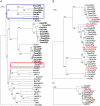Sex-linked pheromone receptor genes of the European corn borer, Ostrinia nubilalis, are in tandem arrays
- PMID: 21526121
- PMCID: PMC3081303
- DOI: 10.1371/journal.pone.0018843
Sex-linked pheromone receptor genes of the European corn borer, Ostrinia nubilalis, are in tandem arrays
Abstract
Background: Tuning of the olfactory system of male moths to conspecific female sex pheromones is crucial for correct species recognition; however, little is known about the genetic changes that drive speciation in this system. Moths of the genus Ostrinia are good models to elucidate this question, since significant differences in pheromone blends are observed within and among species. Odorant receptors (ORs) play a critical role in recognition of female sex pheromones; eight types of OR genes expressed in male antennae were previously reported in Ostrinia moths.
Methodology/principal findings: We screened an O. nubilalis bacterial artificial chromosome (BAC) library by PCR, and constructed three contigs from isolated clones containing the reported OR genes. Fluorescence in situ hybridization (FISH) analysis using these clones as probes demonstrated that the largest contig, which contained eight OR genes, was located on the Z chromosome; two others harboring two and one OR genes were found on two autosomes. Sequence determination of BAC clones revealed the Z-linked OR genes were closely related and tandemly arrayed; moreover, four of them shared 181-bp direct repeats spanning exon 7 and intron 7.
Conclusions/significance: This is the first report of tandemly arrayed sex pheromone receptor genes in Lepidoptera. The localization of an OR gene cluster on the Z chromosome agrees with previous findings for a Z-linked locus responsible for O. nubilalis male behavioral response to sex pheromone. The 181-bp direct repeats might enhance gene duplications by unequal crossovers. An autosomal locus responsible for male response to sex pheromone in Heliothis virescens and H. subflexa was recently reported to contain at least four OR genes. Taken together, these findings support the hypothesis that generation of additional copies of OR genes can increase the potential for male moths to acquire altered specificity for pheromone components, and accordingly, facilitate differentiation of sex pheromones.
Conflict of interest statement
Figures





References
-
- Symonds MRE, Elgar MA. The evolution of pheromone diversity. Trends Ecol Evol. 2008;23:220–228. - PubMed
-
- Cardé RT, Haynes KF. Structure of the pheromone communication channel in moths. In: Cardé RT, Millar JG, editors. Advances in Insect Chemical Ecology. Cambridge, UK: Cambridge University Press; 2004. pp. 283–332.
-
- Tillman JA, Seybold SJ, Jurenka RA, Blomquist GJ. Insect pheromones –an overview of biosynthesis and endocrine regulation. Insect Biochem Mol Biol. 1999;29:481–514. - PubMed
-
- Lassance J-M, Groot AT, Liénard MA, Antony B, Borgwardt C, et al. Allelic variation in a fatty-acyl reductase gene causes divergence in moth sex pheromones. Nature. 2010;466:486–489. - PubMed
-
- Kim CG, Hoshizaki S, Huang YP, Tatsuki S, Ishikawa Y. Usefulness of mitochondrial COII gene sequences in examining phylogenetic relationships in the Asian corn borer, Ostrinia furnacalis, and allied species (Lepidoptera: Pyralidae). Appl Entomol Zool. 1999;34:405–412.
Publication types
MeSH terms
Substances
Associated data
- Actions
- Actions
- Actions
- Actions
- Actions
- Actions
- Actions
LinkOut - more resources
Full Text Sources

